B3.1 Tissues and organs AQA GCSE Biology B3 Organisation and the Digestive System Kerboodle Answer : Page No. 37
Banner 1
- a. A tissue is a group of cells with similar structure and function.
- Organs are collections of tissues performing specific functions.
- a. cell
- organ
- organ
- The stomach is a muscular sac that lies between the esophagusand the small intestinein the upper abdomen.
The stomach is not the only part of your digestive system that absorbs food but rather is a part of the digestive system and important for churning food into a consistency that is easier to digest for the rest of your intestines.
The stomach has three strong layers of muscle tissue to produce churning.
The stomach is where symbiotic bacteria live to help break down food.
The stomach has several pockets that can collect food for later usage.
The stomach can remove unwanted particles from the food that enters it so digestion will happen faster.
B3.2 The human digestive system AQA GCSE Biology B1 Organisation and the Digestive System Kerboodle Answer: Page No. 39
- a. Liver – Producing bile
- Stomach – breaking down large insoluble molecules into smaller soluble molecules
- Small intestine – breaking down large insoluble molecules into smaller soluble molecules and absorption
- Large intestine – absorbing water from undigested food
- An organ is defined as the structure that is formed by two or more primary types of tissues, which execute the functions of the organ. Some of the organs in the body are brain, heart, lungs, stomach, intestine, liver, gallbladder, pancreas, kidneys, endocrine glands, etc.
While organ system is defined as group of organs that work together to carry out specific functions of the body. Each system performs a specific function. Digestive system is concerned with digestion of food particles.
- The esophagus depends on the mouth because without the food broken into smaller bits, you’d choke because the food is too big to go through the tube.
The small intestine relies on the pancreas to produce amylase, protease and lipase enzymes for digestion.
The stomach pummels food with it’s muscles and also produce the protease enzymes (pepsin), which might make digestion easier for the small intestine. The liver produces bile which helps to neutralize stomach acid and also emulsifies fat.
B3.3 The world of the Microscope AQA GCSE Biology B1 Cell Strucutre And Transport . Kerboodle Answer : Page No. 05
Banner 2
- a. Protein molecules are made up of long chains of amino acids.
- Proteins are very important molecules in our cellsand are essential for all living organisms.
Each protein within the body has a specific function, from cellular support to cell signaling and cellular locomotion. In total, there are different types of proteins, including antibodies, enzymes, and some types of hormones, such as insulin.
- Carbohydrates: used for energy. Made of (mono, di, poly)saccharides. Includes starch and fructose. Also it is carbon covalently bonded to water (carbo = carbon + hydrate = water).
Proteins: used for building our body – “cell growth and repair” as Hope Leslie Shy wrote. Made of amino acids. Eaten in meats, grains, etc. Includes enzymes and hormones, hair, skin, and muscle.
Lipids: used for insulation, protection, cell dividers (they repeal water), and stored energy, or fat, (2X that of carbohydrates). Includes waxes, largely make up nuts, and that shiny layer on fruits to keep the water inside.
Proteins and carbohydrates are water-soluble, but most lipids are not, so lipids require some extra work for the body to process.
Carbohydrates are for energy, lipids or fats make our skin soft and our hair shiny, and proteins are for cell growth and repair.
- a.Test for starch:
Add a few drops of iodine to the test sample.
Blue- black means starch is present. - Test for lipids.
Shake sample in ethanol.
Pour into cold water.
Cloudy- white emulsion means lipid is present - Lipids are fatty substances that are organic in nature and do not dissolve in water because of their chemical structure. Lipids are often called fats however lipids can be either fats or oils.
Fats are type of lipids that are solid at room temperature and are derived from animals.
Oils are type of lipids that are liquid at room temperatures and are usually derived from plants.
- All carbohydrates are made up of units of sugars.
Some carbohydrates contain only one sugar unit. The best known of these single sugars is glucose C6H12O6. Other carbohydrates are made up of two sugar units joined together. for example sucrose, the compound we call sugar’ in everyday life. These small carbohydrate units are referred to as simple sugars.
Complex carbohydrates such as starch and cellulose are made up of long chains of simple sugar units bonded together.
Most of the carbohydrates we eat will be broken down to glucose used in cellular respiration to provide energy for metabolic reactions in your cells.
B3.4 Catalysts and Enzymes AQA GCSE Biology B3 Organisation and the Digestive System Kerboodle Answer: Page No. 43
- a. Catalysts increase the rate of chemical reactions without changing chemically themselves.
- Enzymes are proteins. The amino acid chains are folded to form the active site, which matches the shape of a specific substrate molecule.
- Enzymes are biological catalysts and catalyse specific reactions in living organisms due to the shape of their active site. This is the lock and key theory of enzyme action
- a. All enzymes are proteins.
- Enzymes speed up reactions in your body by lowering the activation energy ( the minimum energy needed for a chemical response to occur), or the initial energy input necessary for most chemical reactions to occur. Heat cannot be added to a living system, so enzymes provide an alternate pathway: they bond with a substrate (the substance involved in the chemical reaction) to form a “transition state,” an unstable intermediate complex that requires less energy for the reaction to proceed.
- a. a. Invertase as a catalytic enzyme.
Sucrose -> Glucose + Fructose ( in presence of INVERTASE) - Maltase as a catalytic enzyme.
Maltose-> Glucose +Glucose (in presence of Maltase) - Zymase Glucose -> Ethyl alcohol + CO2
- Lactobacilli Yes, Lactobacillus also acts as enzyme in converting Milk to Curd.
b.Because specific enzymes catalyse specific reactions. That is they speed up the rate of reaction. The rates of reactions would be far too slow at the temperature and pressure inside a cell. In fact many if not the vast majority would not occur at all because the activation energy of the reactions are far too great.
Enzymes lower this activation energy and hence speed up the reaction. Also, reactions can be controlled through feedback inhibition on the enzyme and through the synthesis or degradation of the total amount of enzyme. The majority of enzymes are very specific. So each of the multitude of chemical reactions can be controlled.
B3.6 How the digestive system works AQA GCSE Biology B3 Organisation and the Digestive System Kerboodle Answer: Page No. 147
- a. Enzyme where produced
Amylase salivary glands, pancreas, small intestine
Protease stomach, pancreas, small intestine
Lipase pancreas, small intestine
- Enzymes and their reactions catalysed:
Enzyme reaction catalysed
Amylase starch → sugars
Protease proteins → amino acids
Lipase lipids → fatty acids + glycerol
- Carbohydrate digestion begins in the mouth. The salivary glands in the mouth secrete saliva, which helps to moisten the food.
The food is then chewed while the salivary glands also release the enzyme salivary amylase, which begins the process of breaking down the polysaccharides in the carbohydrate food.
Protein digestion occurs in the stomach and duodenum in which 3 main enzymes, pepsin secreted by the stomach and trypsin and chymotrypsin secreted by the pancreas, break down food proteins into polypeptides that are then broken down by various exopeptidases and dipeptidases into amino acids.

- Optium pH of pancreatic amylase is 7
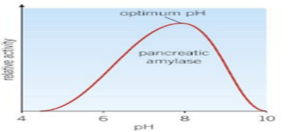
- For example, stomach enzymeshave an optimum pHof 2, which is very acidic. The graph shows what happens to enzyme activity when the pH changes. In the example above, enzyme activity increases between pH 4.5 and pH8. It peaks at pH 8, then decreases.

- Changes in pH may not only affect the shape of an enzyme but it may also change the shape or charge properties of the substrate so that either the substrate cannot bind to the active site or it cannot undergo catalysis. In general enzymes have a pH optimum. However the optimum is not the same for each enzyme.
- Digestion is the mechanical and chemical break down of food into small organic fragments.
It is important to break down macro molecules into smaller fragments that are of suitable size for absorption across cell membranes. Large, complex molecules of proteins, polysaccharides, and lipids must be reduced to simpler particles before they can be absorbed by the digestive epithelial cells. Different organs play specific roles in the digestive process.
The animal diet needs carbohydrates, protein, and fat, as well as vitamins and inorganic components for nutritional balance.
Enzymes are needed in the process of digestion as they are the biological catalysts which break down the large food molecules into smaller ones so that these can eventually be absorbed. Digestion can occur naturally at body temperature, however this process takes a very long time as it happens at such a slow rate.
For digestion to increase in these circumstances, body temperature would have to increase as well. However this is not possible as it would interfere with other body functions.
B3.7 Making digestion efficient AQA GCSE Biology B3 Organisation and the Digestive System Kerboodle Answer: Page No. 49
- a. Hydrochloric acid gives the stomach a low pH suitable for the protease secreted there to work efficiently.
- The pH of your stomach varies, from 1-2 up to 4-5. When you eat, the stomach releases enzymes called proteases as well as hydrochloric acid to aid in digestion. By itself, the acid doesn’t really do much for digestion, but the proteases that cleave proteins work best in an acidic environment or low pH, so after a high-protein meal, your stomach pH may drop to as low as 1 or 2. However, buffers quickly raise the pH back to 3 or 4. After the meal has been digested, your stomach pH returns to a resting level of about 4 or 5.
- The enzyme made in the pancreas and small intestine work best in the alkaline condition.
- Bile produced by liver, stored in the gall bladder and released through bile duct. Alkaline bile neutralize the acid and gives a high pH for the enzymes from the pancreas and small intestine to work well.
- a. Bile emulsifies the fats means bile physically break up the large drop of fat into small droplets.
This provides a bigger surface area of the fat for lipase to act upon it.
Lipase break down the fat into fatty acid and glycerol.
- The digestive enzyme, pancreatic lipase, is water soluble and can only work at the surface of fatglobules.
Digestion is greatly aided by emulsification, the breaking up of fat globules into much smaller emulsion droplets. Bile salts and phospholipids are amphipathic molecules that are present in the bile.
- Before your food passes from the mouth and down your esophagus, salivary amylase, an enzyme in saliva, begins to digest the starch in your bread. That is the start of chemical digestion.
The passage of the bolus through the esophagus to the stomach occurs by peristalsis, a series of wave-like muscle contractions.
Summary Questions AQA GCSE Bilogy B3 Organisation and the Digestive System Kerboodle Answer: Page no. 50
1 a. Group of organs that all work together to carry out a particular function
- A = stomach
B = pancreas
C = large intestine
D = small intestine
E = gall bladder
F = mouth
- muscle tissue: contracts to mix food and digestive enzymes.
glandular tissue: contains cells that secrete substances such as mucus, acid or enzymes to aid digestion.
- a. Simple sugar is carbohydrate made up of single sugar molecule. Complex carbohydrate is made up of long chains of simple sugar units bonded together.
- carbohydrates are broken down to give glucose used in cellular respiration to provide energy.
- Benedict’s test blue Benedict’s solution turns brick red
on heating if sugar such as glucose is present
- a.
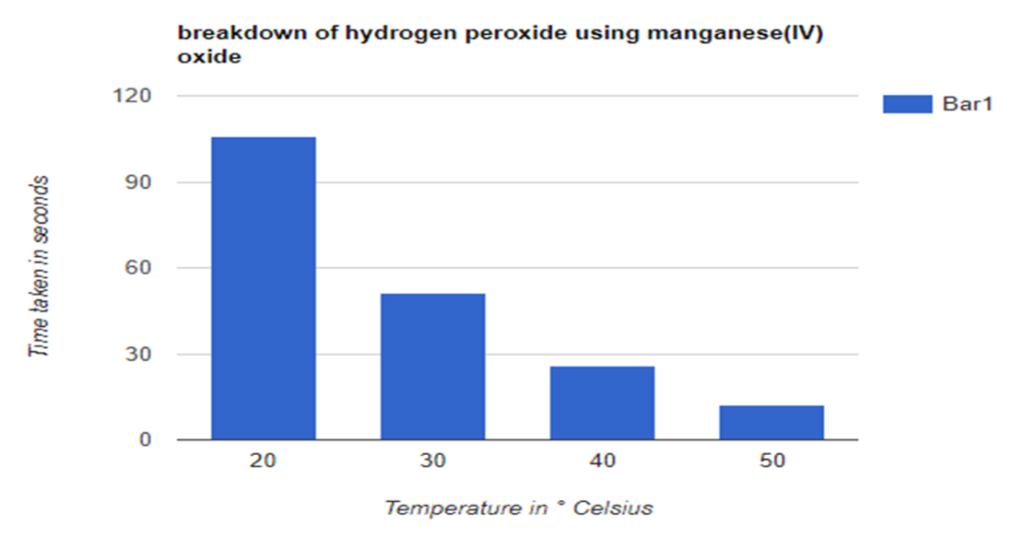
- Reaction speeds up with increase in temperature.
as temperature increases particles move faster and with more energy
so more likely to collide and react.
- catalase.
- rate of reaction increases up to about 40 °C
before decreasing and eventually stopping
- reaction catalysed by manganese(IV) oxide is a chemical reaction
- and is not adversely affected by temperature
- enzyme-catalysed reaction has optimum temperature
- beyond which enzyme is denatured, shape of active site is lost, and
- reaction can no longer be catalysed.
- carry out test at temperatures around 40 °C to determine at which
temperature breakdown is fastest.
4.a. temperature
concentration of enzyme or substrate
- test enzyme activity at shorter intervals (more frequently)
test enzymes at same temperature.
- enzyme A works best in slightly alkali environment (pH 8),
as this is when maximum activity (32 au) is recorded
enzyme B works best in acid environment (pH 2 or lower)
as this is when maximum activity (26 au) is recorded
d.
- A = trypsin
- works best in slightly alkaline pH
- small int uestine is alkaline due to alkaline bile that neutralises the acid
- stomach contents
- B = pepsin
- works best in acid pH
- stomach produces hydrochloric acid and has acid pH (pH 2)
Practice Questions AQA GCSE Bilogy B3 Organisation and the Digestive System Kerboodle Answer: Page no. 51
- The basic building block of living organisms is called a cell
A group of cells with similar structure and function is called a tissue
The brain is an example of an organ
02.1. A eye
B liver
C kidney
D testis.
02.2. eye / A.
03.1. A group of organs that work together to perform a specific function
03.2.
- to digest food
- to absorb food (molecules)
03.3.
- produces protease
- produces hydrochloric acid
- to provide the correct pH for the enzyme to work
04.1. too hot and the enzyme might be denatured
- cooler and the enzyme would work more slowly
- warmer and the enzyme would work faster
04.2. iodine solution
turns black / blue-black
4.3 the time for the starch to be digested / disappear
04.5. 7.3
04.6. same result at pH 7 and 7.5
- interval between pH values too wide
- accuracy of result only to nearest half minute
- no mention of repeats
Banner 3
Disclaimer
Disclaimer: I have tried by level best to provide the answers and video explanations to the best of my knowledge. All the answers and notes are written by me and if there is any similarity in the content then it is purely coincidental. But this is not an alternative to the textbook. You should cover the specification or the textbook thoroughly. This is the quick revision to help you cover the gist of everything. In case you spot any errors then do let us know and we will rectify it.
References:
BBC Bitesize
AQA GCSE Science Kerboodle textbook
Wikipedia
Wikimedia Commons
Join Our Free Facebook Group : Get A* in GCSE and A LEVEL Science and Maths by Mahima Laroyia: https://www.facebook.com/groups/expertguidance.co.uk/
For Free Tips, advice and Maths and Science Help
This page contains the detailed and easy notes for AQA GCSE Biology Cell Biology for revision and understanding Cell Biology.
Banner 1
AQA GCSE Paper 1: Complete Revision Summary
ORGANISATION
Banner 2
4.2 Organisation
- Organisation hierarchy
- Human Digestive System
- Circulatory System
- Heart and the blood vessels
- Blood
- Coronory Heart Disease
- Non Communicable Disease
- Respiratory System
- Plant Tissues
- Plant Organ System
- Transpiration
Banner 3
LIVING SYSTEM HIEARARCHY
CELLS
- Nerve Cell
- Muscle Cell
TISSUES
- Muscular tissue
- Epithelial tissue
- Glandular tissue
ORGANS
- Stomach, kidney, liver, pancreas, Heart
ORGAN SYSTEM
- Circulatory System,
- Digestive System
- Nervous System
- Excretory System
ORGANISMS
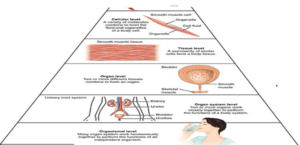
Digestion
It is the process of breaking down large insoluble food particles in the food into soluble small particles which can then be absorbed into the blood
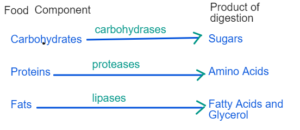
Banner 4
DIGESTION PROCESS
INGESTION –
- It happens with the help of mouth and tongue
- Taking in of food with the help of mouth.
- The teeth and tongue helps in churning the food and mixing with saliva.
DIGESTION –
- It happens with the help of stomach, intestine , pancrease and liver
- Breakdown of large insoluble particle into small soluble ones
ABSORPTION –
- Small Intestine
- The process by which digested food particles are absorbed into the blood
ASSIMILATION –
- In the body cells
- Using the absorbed food for releasing energy and in body processes.
EGESTION –
- By rectum and Anus
- Getting rid of undigested food materials.
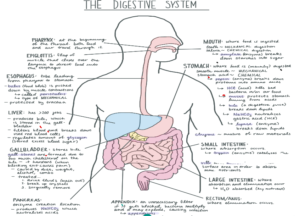
Banner 5
BILE JUICE
- It is the green yellow alkaline liquid which is produced in the liver and stored in the Gall Bladder.
- It performs two major Functions:
NEUTRALIZATION
- The food that comes from the stomach is acidic and the enzymes of the intestine can work in alkaline conditions.
- The bile neutralizes the food that comes from the stomach and makes it alkaline so that the enzyme released in the intestine can work effectively.
EMULSIFICATION OF FATS
- For lipase to work, the fat must be broken down into small droplets to increase the surface area for the lipase to function.
- The bile perform this function of emulsification of fats for the efficient working of lipase.
Baneer 6
COMPONENTS OF FOOD
| Food Component | Source | Monomer | Enzyme | Location | Function |
| Carbohydrates | Breads, pasta, Cereals; Rice | Sugars | Carbohydrase eg Amylase | Mouth and small intestine | Principal source of energy Fuel for respiration Storage molecules like starch and glycogen Structure molecule like cellulose |
| Proteins | Pulses, chicken Meat, poultry Eggs, Beans Nuts | Amino Acids | Protease | Stomach and small intestine | Components of muscles. Required for growth and repair. components of enzymes Hormones like insulin |
| Fats | Butter, Oil; Margarine, | Fatty Acids + Glycerol | Lipase | Small Intestine | Insulates the body Reserve source of Energy components of cell membrane |
ENZYMES
- They are biological catalyst that increases the rate of a biological reaction without being used up.
- They increases the rate of the reaction by providing an alternative route that works by lowering the activation energy.
- They are protein in nature so they are sensitive to heat and pH.
LOCK AND KEY MODEL
Enzymes are highly specific due to the active site. As the active site has a shape complimentary to the substrate. So the specific substrate molecule can fit into the active site of the enzyme.
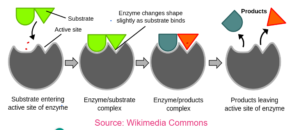
FACTORS AFFECTING ENZYME ACTIVITY
SUBSTRATE CONCENTRATION
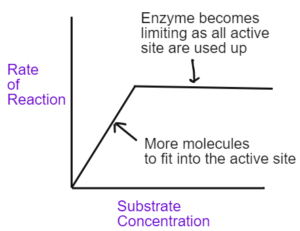
ENZYME CONCENTRATION
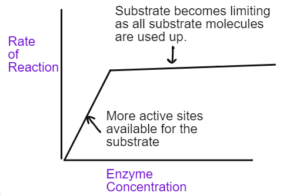
FACTORS AFFECTING ENZYME ACTIVITY
Temperature
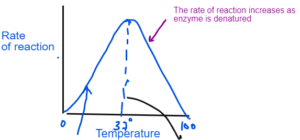
| Denaturation is the change in the shape of the enzyme with increase in temperature and pH beyond optimum which results in the change in shape of the active site As a result, substrate molecules can no longer fit into the active site decreasing the rate of the reaction. |
- Rate of reaction increases as particles gain kinetic energy and they collide more increasing
- The optimum temperature. It is the point where the enzyme activity is the highest.
pH
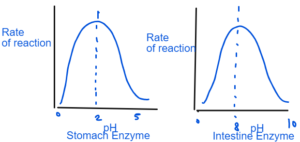
- Different enzymes has different pH optimum.
- Stomach enzymes works in acidic conditions which are maintained by hydrochloric acid Intential enzymes works in alkaline pH maintained by bile
CIRCULATORY SYSTEM
The system that provides the bosy with oxygen, nutrient, hormones and all the essential things required by the body to survive. It also eliminate the waste products.
PUMPING ORGAN
- It the heart that pumps the transporting medium all around the body.
- HEART
TRANSPXTING MEDIUM
- It is the blood which contains all the dissolved substances and oxygen required by the body.
- BLOOD
VESSELS
- They carries the blood from one part to another.
- ARTERIES
- VEINS
- CAPILLARIES
BLOOD
BLOOD PLASMA
- It is the liquid component of the blood.
- It makes 55% of the blood.
It is composed of:-
- Glucose
- Amino Acids
- Hormones
- Waste Products like Urea
- Carbon Dioxide
BLOOD CELLS
RED BLOOD CELLS
- It transport oxygen all around the body. It is a specialised cells
- Biconcave disc
- Increases the surface area for oxygen transport
- No nucleus
- To provide more room for oxygen contains haemoglobin
- Binds with oxygen to carry it around the body
WHITE BLOOD CELLS
- They are soldiers of the cells
- The protect the body from infections
- They are made up of lymphocytes which produce antibodies.
- They also have phagocytes which engulfs the pathogen
PLATELETS
- They are involved in blood clotting
- They have fibrin proteins which forms the mesh around the blood

NEED FOR CIRCULATORY SYSTEM
LOW SURFACE AREA TO VOLUME RATIO
- Multicellular organisms due to their bigger size have very low surface area to volume ratio.
- As a result, diffusion alone is not effective to meet the demands of the cell so it requires a circulatory system.
METABOLICALLY ACTIVE
- The multicellular organisms are metabolically active. So they need constant supply of oxygen and food and constant removal of waste products.
MULTICELLULAR
- Being multicellular many cells are deep and the diffusion distance is larger.
- So they need a circulatory system that transport substance deep inside the cells.
DOUBLE CIRCULATON
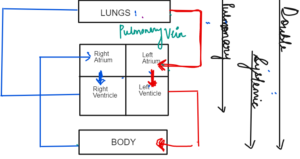
| Pulmonary vein |
| AORTA |
- In One complete cycle the blood is pumped into the heart twice.
- It involves two circulation: Pulmonary: Circulation between Lungs and Heart
- Systemic Circulation: Circulation between heart and the body
- Double circulation makes the circulation more efficient by preventing the mixing of oxygenated blood and helps to alter the pressure from the different chambers of the heart
Banner 7
Heart
- Heart is the pumping organ
- Working all day and night
- It has four chambers
- Atrium are at the top and Ventricles are at the bottom.
- Ventricles have thicker wall than the atrium.
- Left Ventricle have the thickest wall amongst all other chamber
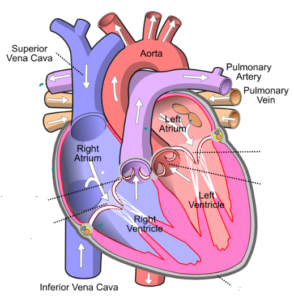
BLOOD VESSELS
| ARTERIES | VEINS | CAPILLARIES |
| Carries the blood away from heart | Comes the blood to the heart | Connects arteries and veins |
| Has thick muscular elastic wall | Thin elastic wall | Once Cell thick |
| Narrow Lumen | Wider Lumen | Very small Lumen |
| They do not have valves | They have valves | They do not have valves |
| The blood flows at a high pressure | The blood flows at a lower pressure | The blood flows at a lower pressure. |
| They carry oxygenated blood except pulmonary artery. | They carry deoxygenated blood except pulmonary vein | They carry both oxygenated and deoxygenated blood. |
CORONORY HEART DISEASES
- Coronory Artery that supplies the blood to the arteries become narrow.
- The fatty materials like cholesterol gets deposited and narrow the artery.
- The narrowed artery reduced the blood flow to the heart.
- The blood flow to the heart is reduced.
- The heart do not get enough oxygen.
- This causes heart pain, chest pain and heart attack.
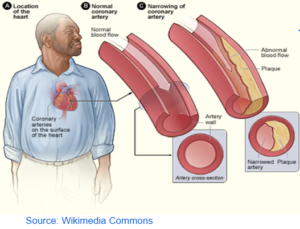
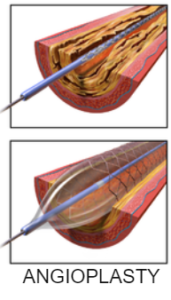
Treatment of Coronory Heart Disease.
- A Stent is placed with the baloon in the blocked artery.
- The blocked artery is opened by inflating the baloon.
- The metal mesh stent keep the stent in place.
- This resumes the blood flow.
- People can also be given statin which lowers the blood cholesterol and prevent the deposition of the cholestrol.
- The blood flow to the narrow artery is byepassed to the graft taken from another part of the body
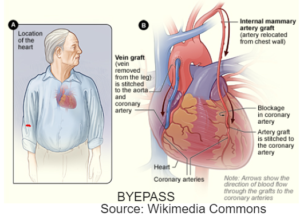
Banner 8
PROBLEMS TO THE HEART
LEAKY VALVES
- Due to increases pressure of blood flow the valves start to leak.
VALVE REPLACEMENT
- The valves made up of metal or polymers or the biological valves from animals can be used to replace the faulty valve
IRREGULAR HEART BEAT
- The natural pacemaker which are the group of cells at the top of the right atrium that regulates the heart beat do not function properly.
ARTIFICIAL PACEMAKER
- Electrical devices called the artificial pacemaker takes over the function of natural pacemaker.
HEART FAILURE
- When the heart do function properly
HEART TRANSPLANT OR ARTIFICIAL HEART
- Artificial heart or heart transplant from the donor.
HUMAN GAS EXCHANGE SYSTEM
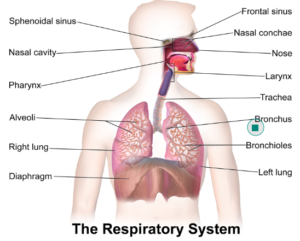
MECHANISM OF BREATHING
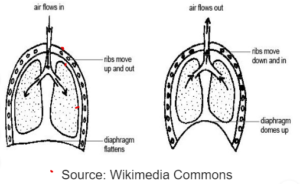
Banner 9
GAS EXCHANGE
ALVEOLI
GREATER SURFACE AREA
SHORTER DIFFUSION DISTANCE
STEEP CONCENTRATION GRADIENT
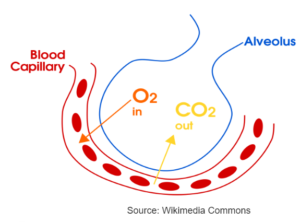
ORGANISATION IN PLANTS
CELLS
TISSUES
- Xylém and Phloem
- Palisade mesophyll tissue
- Spongy mesophyll tissue
ORGANS – Root, Stem and Leaves
ORGAN SYSTEM – Water Transport System
ORGANISM
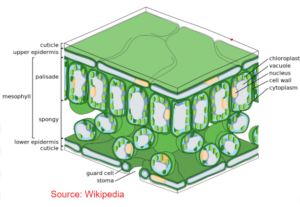
TRANSPIRATION
- Transpiration is the loss of water from the surface of the leaves in the forms of water vapours.
- In plants it takes place through the stomata.
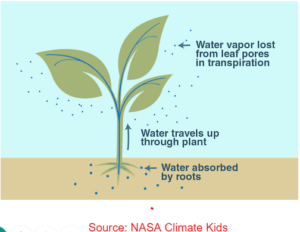
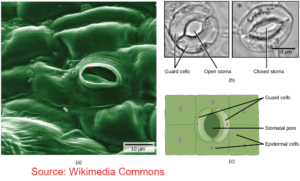
FACTORS AFFECTING TRANSPIRATION
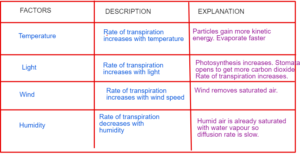
MEASURING RATE OF TRANSPIRATION
- Potometer is the device which is used to measure the rate of water uptake or the rate of transpiration.
- The movement of bubble is an indicator of water movement which in turn shows the rate of transpiration
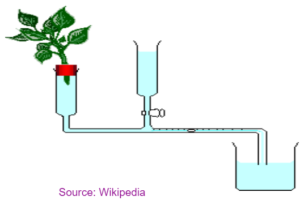
ADAPTATIONS TO LIMIT TRANSPIRATION
- Cuticle layer on the leaf which is waterproof prevent rate of transpiration
- Stomata are present on the lower surface to reduce rate of transpiration.
- Some plants stomata open is night and closes in day.
- In plants like cactus the leaves are reduced to spines to decreases the surface area for water loss.
- Some plants have sunken stomata.

Banner 10
Disclaimer:
I have tried my level best to cover the maximum of your specification. But this is not the alternative to the textbook. You should cover the specification or the textbook thoroughly. This is the quick revision to help you cover the gist of everything. In case you spot any errors then do let us know and we will rectify it.
References:
BBC Bitesize
Wikipedia
Wikimedia Commons
Image Source:
Wikipedia
Wikimedia
Commons
Flickr
Pixabay
B3- Organisation And the Digestive System
- Principles of Organisation QP1
- Principles of Organisation MS1
- Principles of Organisation QP2
- Principles of Organisation MS2
- Blood Questions
- Blood Answers
- Heart and Blood Vessels QP
- Heart and Blood Vessels MS
- Coronary Heart Disease QP
- Coronary Heart Disease MS
- Health Issues QP
- Health Issues MS
- Human Digestive System QP
- Human Digestive System MS
- Effects of Lifestyle and Cancer QP
- Effects of Lifestyle and Cancer MS
- Enzymes QP
- Enzyme MS
